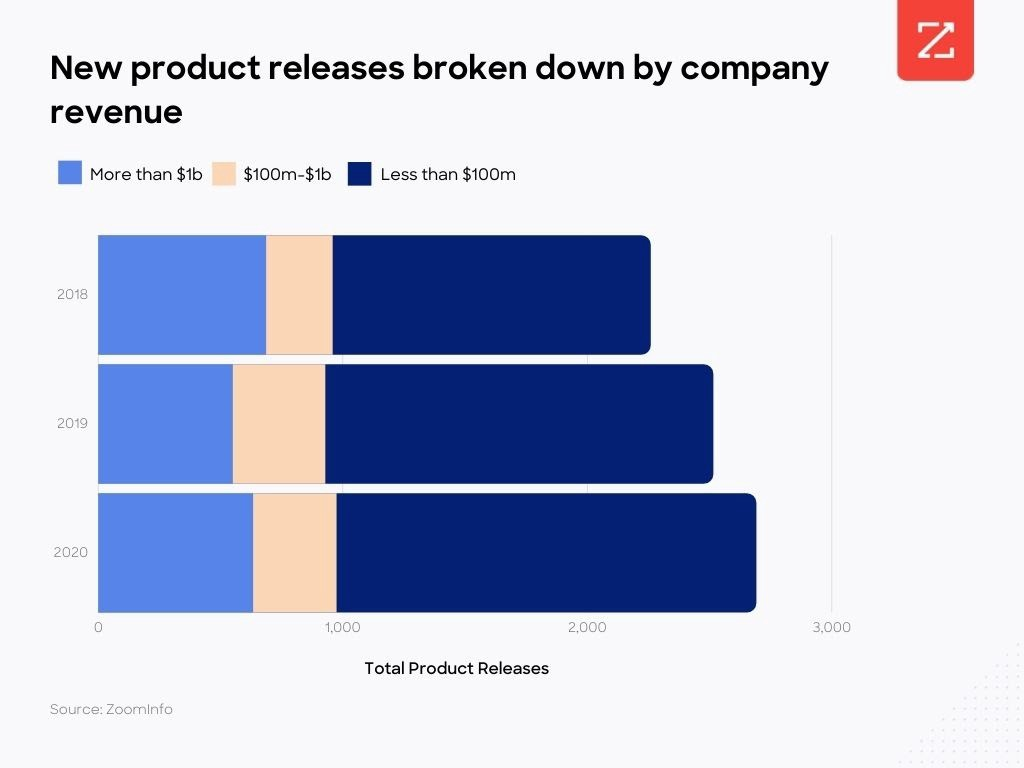Sales account management, like sales, is selling. For the sales account manager, getting processes down can mean the difference between achieving massive growth and losing customers to the competition.
The lines between sales and account management get blurry — while they’re both revenue powerhouses, they’re different beasts. Let’s do a quick overview.
What Is the Difference Between Sales and Account Management?
When it comes to sales versus account management, they share the common goal: Always Be Closing.
While both focus on selling, the ‘roles’ are different.
Sales account management, however, focuses on building long-term relationships with key customers for up-selling and cross-selling purposes.
As a sales account manager, consider this:
In 2020 (during the global pandemic), there were more product releases than in the prior two years, with small and large businesses out-innovating the mid-market.

With increased innovation, there are greater selling opportunities for account managers.
As new products roll out, sales account managers can offer product upgrades to help their customers reach business goals. However, to do that well requires smart planning, including how to:
Define your account management responsibilities
Revamp your sales account management approach
Audit your sales account management data
To ensure you reach your account sales goals while continuing to nurture your customer relationships long-term, let’s look at the sales account management best practices to implement now.
1. Define Your Account Management Responsibilities
Your sales account managers will have different strengths and selling approaches. Some are hunters who thrive on closing deals.
Others are like farmers, nurturing customers beyond the initial sale. (Your hunters are possibly too aggressive for building long-term relationships with key accounts.)
However, sales account managers have multiple responsibilities — from resolving customer issues to hitting revenue goals.
Sales-critical tasks, such as upselling a complex solution to an existing customer, may overload managers, reducing their performance outcomes.
Start by defining strategic account management responsibilities.
For instance, who will drive results? Your ever-hungry ‘hunter’ might fit this role ensuring always-climbing growth. Conversely, your relationship lead will keep the customer’s eyes on your products, while heading off competitors’ shiny-object tactics.
The sales account managers will most likely fill multiple roles. The key is to assign them responsibilities that fit their selling strengths.
The key to a great sale is to identify your decision makers – learn how data can help. https://t.co/pXUpjOdq03— ZoomInfo (@ZoomInfo) January 20, 2021
2. Revamp Your Sales Account Management Approach
Let’s start with a question: What drives your account management growth?
While exceptional customer service is critical for nurturing accounts, without growth, the model fails.
Rather than falling in line with ‘how it’s always been done,’ that is, focusing on customer service, account managers have greater success with a ‘customer improvement’ approach.
This customer improvement foresight and proactive approach can galvanize the selling relationship and open the way for new sales.
3. Audit Your Sales Account Management Data
What used to work for managing accounts — the account manager’s contacts spreadsheet and stored phone numbers and email addresses — transformed into customer relationship management (CRM).
No matter what you’ve got in your current tech stack, your account manager digital solutions are only as good as the data going into them.
This inaccuracy happens at any given time — seller tools have a hard time keeping up with the rapid pace of business events such as promotions, acquisitions, product launches, and so much more.
30-50% of CRM and ERP data is inaccurate.Henry Schuck, Founder and CEO of ZoomInfo.
Sales account managers, with access to real-time data, can monitor accounts with less effort and greater accuracy. That includes setting up automated alerts for customer-related events, such as new rounds of funding, leadership changes, or technology purchases.
With that type of intel, your account managers can create selling opportunities with existing accounts for the right product at the right time.
Next Steps for Better Sales Account Management
Whether you manage high-profile key accounts or multiple startup customers, it’s your responsibility to build a relationship that hopefully stretches well into the future. At the same time, that connection must produce revenue.
To ensure you hit those annual targets, you’ll need team members whose selling strengths fit the account.
Additionally, you must have access to the best data possible, and the drive to improve your customer’s business.


